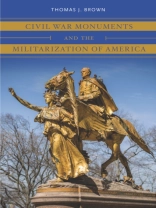This sweeping new assessment of Civil War monuments unveiled in the United States between the 1860s and 1930s argues that they were pivotal to a national embrace of military values. Americans’ wariness of standing armies limited construction of war memorials in the early republic, Thomas J. Brown explains, and continued to influence commemoration after the Civil War. As large cities and small towns across the North and South installed an astonishing range of statues, memorial halls, and other sculptural and architectural tributes to Civil War heroes, communities debated the relationship of military service to civilian life through fund-raising campaigns, artistic designs, oratory, and ceremonial practices. Brown shows that distrust of standing armies gave way to broader enthusiasm for soldiers in the Gilded Age. Some important projects challenged the trend, but many Civil War monuments proposed new norms of discipline and vigor that lifted veterans to a favored political status and modeled racial and class hierarchies. A half century of Civil War commemoration reshaped remembrance of the American Revolution and guided American responses to World War I. Brown provides the most comprehensive overview of the American war memorial as a cultural form and reframes the national debate over Civil War monuments that remain potent presences on the civic landscape.
Thomas J. Brown
Civil War Monuments and the Militarization of America [PDF ebook]
Civil War Monuments and the Militarization of America [PDF ebook]
Cumpărați această carte electronică și primiți încă 1 GRATUIT!
Limba Engleză ● Format PDF ● Pagini 384 ● ISBN 9798890856777 ● Editura The University of North Carolina Press ● Publicat 2019 ● Descărcabil 3 ori ● Valută EUR ● ID 9200825 ● Protecție împotriva copiilor Adobe DRM
Necesită un cititor de ebook capabil de DRM












